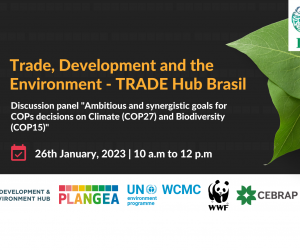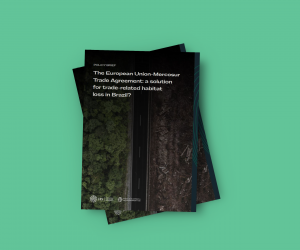UKRI GCRF Trade, Development and the Environment Hub

According to the Brazilian Institute of Geography and Statistics (IBGE), the Brazilian harvest of grains should hit another record in 2021, the third in a row, adding up to 260.5 million tonnes, an increase of 2.5% over last year’s record. Brazil was the world’s largest soybean producer in the harvest that ends in 2020, taking back from the United States the position of the world’s largest soybean producer, and it is in addition to being the world’s largest soy exporter .
In the same time, Brazilian biogeographical regions have lost natural areas and registered an increase in the number of flora and fauna species threatened with extinction. The data show that about 500 thousand km² of natural coverage were lost between 2000 and 2018, due to pasture and accelerated agriculture expansion. According to Food and Agriculture Organization (FAO) , about 80% of deforestation in the Amazon region is due to livestock activity. According to Vasconcelos et al. (2020) , it is estimated that, between 2012 and 2017, over a quarter of the total deforestation in Mato Grosso, the largest grain producing state in Brazil, took place on soybean farms – mostly illegally given the lack of licenses. It is also estimated that 2% of properties in the Amazon and Cerrado are responsible for 62% of all potentially illegal deforestation. As a consequence, Brazil had 3,299 species of animals and plants threatened with extinction.
As a response, the foreign market has increasingly demanded that commodities imported from Brazil be free from illegal deforestation and consequently from biodiversity loss. According to World Trade Organization (WTO) , international trade has a central role in achieving sustainable development. The issues related to responsible consumption and production, together with maintaining biodiversity and nature’s contributions for people (ecosystem services), can be particularly important when looking at international trade flows for soybeans and other commodities. Besides this, there is a growing debate about how to encourage farmers to conserve natural areas beyond the legal requirements of Native Vegetation Protection Law (LPVN).
In this context, one of the main challenges for agricultural sustainability is how to increase production without causing further biodiversity loss. The land use change without sustainable planning and causing large deforestation can bring several consequences for Brazil’s environmental standing and damaging repercussions for its agribusiness sector and market access.
The UKRI GCRF Trade, Development and the Environment HUB aims to provide data, analyses, ideas and partnerships that accelerate the transition to a sustainable global trading system, reducing its impacts on biodiversity and people, increasing social benefits from the use of wild species and agricultural production.
This Hub includes economists, trade modellers, political scientists, ecologists, development scientists, large companies, UN bodies and nongovernmental organisations which will work together across supply chains to influence trade-related policies and practices. It will also produce research to help ensure that trade becomes a driver of positive change in the world, halting biodiversity loss and lifting people permanently out of poverty.
Alongside 50 institutions from 15 different countries, IIS role within the Trade Hub scope is to analyse the land use and biodiversity outcomes of agricultural commodity production and international trade scenarios. The goal of IIS research is to contribute to this debate through the use of spatially explicit economic-environmental modeling on land use, exploring different measures for the effective implementation of national policies, combined with different solutions for implementing safeguards in trade agreements.
Visit the Trade Hub website: https://tradehub.earth/
Related Themes
Related Content

13.03.23
IIS launches online platform with priority areas for ecosystems conservation and restoration around the world

13.04.23
Video: PLANGEA Web International Launch

17.01.23
Video: discussion panel “Ambitious and synergistic goals for COPs decisions on Climate (COP27) and Biodiversity (COP15)”

Holistic spatial planning is imperative to operationalise transformative goals: recommendations for the post-2020 Global Biodiversity Framework

Policy Brief: The European Union-Mercosur Trade Agreement: a solution for trade-related habitat loss in Brazil?

05.03.21
Workshop on agricultural commodities production and trade scenarios outcomes on land use change and biodiversity in Brazil












